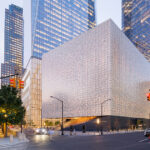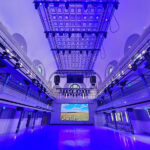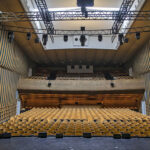There’s a new player on the Las Vegas Strip: The Palazzo — “palace” in Italian — is a AAA five-diamond luxury hotel and casino resort offering the height of sophistication and elegance. But the $1.9 billion Palazzo is also the largest LEED-certified building in the world, having been awarded Silver LEED (Leadership in Energy and Environmental Design) status by the U.S. Green Building Council in recognition of the property’s commitment to “green” technology and construction across categories of sustainable sites, water efficiency, indoor environmental quality, materials and resources, and energy and atmosphere.
A sister property to The Venetian, The Palazzo is owned by Sands Group and opened in January 2008. Entertainment lighting systems company 4Wall Entertainment — with locations in Las Vegas, New York and Phoenix — tackled this project alongside lighting designer Martin van Koolbergen, who is a partner at Kaplan Gehring McCarroll Architectural Lighting in Los Angeles.
For Buddy Pope, senior project manager at 4Wall, a significant challenge of this project was simply the size of the property.
“We have a nine-page spreadsheet of all of the equipment,” he says. 4Wall divided the project into two sections: the podium — including the casino, the retail mall and public spaces — “and the rest of it; the restaurants, the shops, the theatre, the night clubs, the spa, all that kind of stuff.”
“The podium had 23 dimmer racks in it by itself, along with a monster amount of control stations,” Pope says.

But the biggest challenge in lighting the space was energy conservation. With two years between ground breaking and opening, the project was already mid-way through construction when the decision was made to seek LEED certification.
“The Palazzo had started as a very environmental project to begin with,” Koolbergen explains. “They were already approaching a lot of the systems for LEED certification. It was a natural path to say, ‘Okay, if we’ve come this far, we might as well continue.’”
But the property still needed to open on schedule. With several hundred types of fixtures, both interior and exterior, Koolbergen faced a big challenge. Where there originally had been no wattage restrictions, Koolbergen found himself suddenly limited to a mere 0.5 watts per square foot in the tower corridors, for example.
“And .5 watts is a very low level compared with what’s typical in lighting corridors in any of the casino towers,” he says. “It was a very strict requirement to create the moods that were required. The primary challenge was to retrofit the original design to bring The Palazzo into compliance with the LEED certification system.”
When asked how many iterations the lighting design went through, Koolbergen laughs.
“We made constant changes to it,” he says. “It was a completely fluid project. We’re constantly refining the architecture and the lighting design to create the best moods. Something would be suggested, something would be designed, and as it was going up and we’d all be at the site; we’d look to see how that could be improved.”

Coming from California with stringent restrictions from Title 24, the California Building Standards Code, Koolbergen and KGM are always looking to the most energy efficient lighting and control systems. To meet the even more restrictive LEED requirements, Koolbergen took things a step further to help The Palazzo — four-times larger than the previous largest LEED-certified structure worldwide — to attain silver status.
“In typical cove lighting conditions in any casino, we all were accustomed to using cold cathode or neon to illuminate the coves,” Koolbergen explains. Instead, the decision was made to go to a linear LED product produced by GE Supply.
“It was very interesting to see what the differences were in terms of the energy savings for that, and the colors that were acceptable, based on the new fixture types, to accentuate the warmth of the architecture,” says Koolbergen. “It was certainly a challenge that we got the same outcome that we were used to getting in previous years.”
But in the end, Koolbergen didn’t have to compromise on color.
“The central configuration of the casino is a giant backlit glass barrel vault, and there was a series of mock-ups with color changing LEDs,” he explains. “We would say, yes, that’s the color we should use. But then the owner would come in and say, okay, this is the color we should use.”
Koolbergen laughs about the back-and-forth discussions, but says the warm ambience called for in the design was easily achieved.

When describing the main goals of the design, Pope and fellow 4Wall Project Manager Darin Hagen respond simultaneously: “Make it work.” They then cite the need for controllability and ease of maintenance in addressing the energy management requirements for the property’s LEED certification.
From a more aesthetic standpoint — while still operating within the LEED restrictions — Koolbergen’s job was to enhance The Palazzo’s traditional architectural components with hidden sources, giving the appearance that the decorative fixtures are illuminating the space.
“We wanted to accentuate the elegance of that space, refined elegance with a sophisticated atmosphere,” he says. “We highlighted individual elements to create drama in the open space planning and accentuate the art and sculpture displayed throughout the project.”
As for the tower, The Palazzo stands out from its sister property, The Venetian. A high-pressure sodium light source was chosen for The Palazzo’s tower, in contrast to the metal halide source used to illuminate The Venetian.
“While the architecture might be similar, the lighting had a slight twist to it to kind of set it apart on the Strip,” Koolbergen says.

For The Palazzo podium’s entertainment lounge, “we got a Wholehog,” says Pope. He describes the area as a theatrical rig with a small stage, Color Kinetics for color and the exterior of the building.
Koolbergen says it’s unusual to use so much daylight in a casino property, and this speaks to the green-mindedness of the overall project. The Palazzo’s two- and three-story circulation spaces are equipped with skylights and glazed windows.
“Typical casinos are very driven from the inside without any natural light,” says Koolbergen. “Using the ETC Unison system, we were able to save energy because of the daylight harvesting that was available, dimming lights in response to the amount of available natural light.”
Photo cells and astronomical timers were also used to conserve energy. Pope and Hagen regularly choose ETC on 4Wall projects for “reliability, customer support, ease of installation and the high level of controllability.” It was a natural fit for The Palazzo, as LEED certification requires lighting controllability.
“A lot of properties, they just run circuits back to breaker panels,” Pope says. “Being able to dim any circuit in the building is definitely unique.”
“We relied on the control system to allow us to raise and lower light levels to give us increased lamp life, utilizing that system to its fullest potential, and then utilizing new lamp sources,” Koolbergen explains. “We didn’t necessarily have to change many of the actual fixtures that had already been ordered. We just had to reconfigure some of the lamping inside of it.”
Koolbergen says the ETC Unison system with ETC Sensor-Plus dimming is very energy efficient and makes lighting control uncomplicated when creating different moods — whether in response to daylight streaming into the casino through skylights, or to evoke a more intimate atmosphere in the entertainment lounge.
“The lighting control system was in response to the circuiting that we had created so that the lights on the wall could be separately regulated from lights that are highlighting the gaming tables, from the decorative fixtures to create a balance of lighting in the space itself,” Koolbergen says.
The Palazzo’s control system is entirely network-based in the podium area and in many other venues of the Palazzo property — including the Jersey Boys Theater and most of the restaurants. The resort’s two nightclubs — Sushi Samba and Lavo — are a hybrid of Ethernet and DMX.
Many of The Palazzo’s lighting elements, seamlessly integrated and designed to underscore what Pope calls “the opulence of Las Vegas,” are components that most visitors won’t even notice. There are eleven columns in The Palazzo casino finished in $6,800-per-square foot Lalique crystal, backlit with Color Kinetics LEDs. Each piece of crystal is individually numbered and signed.
“No one notices this at all,” says Hagen. Pope relates an anecdote about an inebriated casino patron who smashed a piece of the crystal with a beer bottle during an argument. The man cooled down, apologized and offered to pay for the damage.
“Then when they went to charge his credit card the $8,000 to replace this one piece of glass, he realized it was something a little more than just a piece of glass!” said Pope.
While The Palazzo’s two-story, backlit waterfall in the galleria is hard to miss, there are also the casino’s four vaulted ceilings lined with just under a mile of Color Kinetics LEDs.
“We totaled almost three miles worth of Color Kinetics on the whole building,” Pope says. “The ETC dimmer modules, if you were to line them up end to end, I think were almost about a mile long.”
But Pope says that’s the goal in architectural lighting and controls: “You don’t want people to notice the fact that stuff dimmed. You just want them to notice the space and how nice the space is.”
In the end, the years of hard work, attention to design details and even the scramble to meet LEED certification have all paid off.
“The amount of energy that was saved was incredible,” says Koolbergen. “Over 10.6 million kilowatts of energy are conserved annually. It’s enough to brew six million cups of coffee.”
Pope says he’s heard nothing but great reviews. “Everybody loves it. It’s nice. It’s new. It’s clean. It’s pretty.”
“The owners are in love with the way that the space has come out,” Koolbergen agrees. “The ‘wow factor’ has been achieved.”


